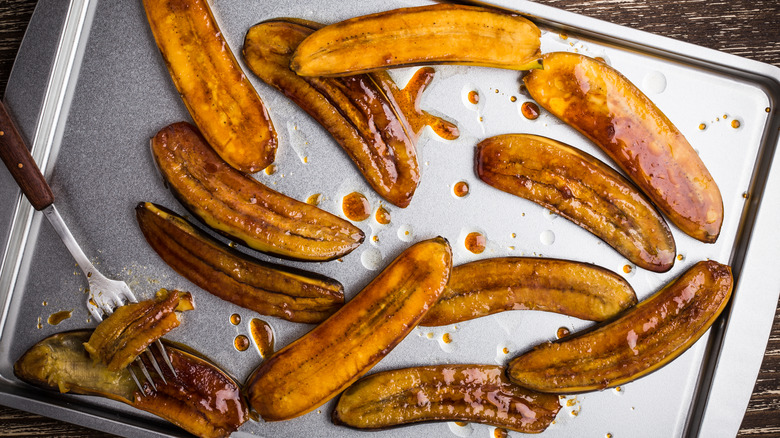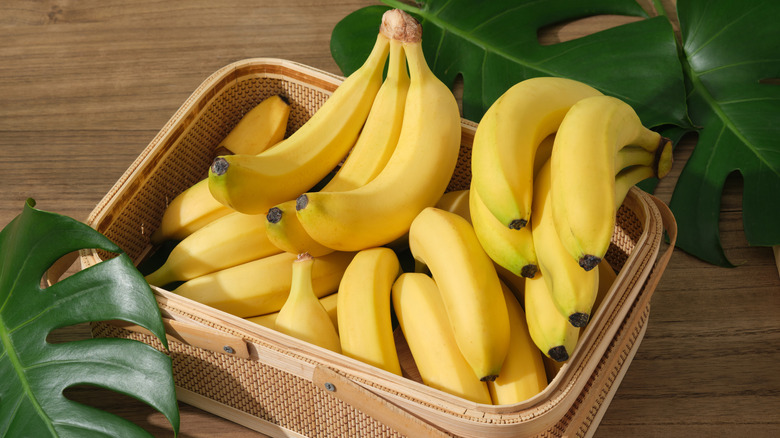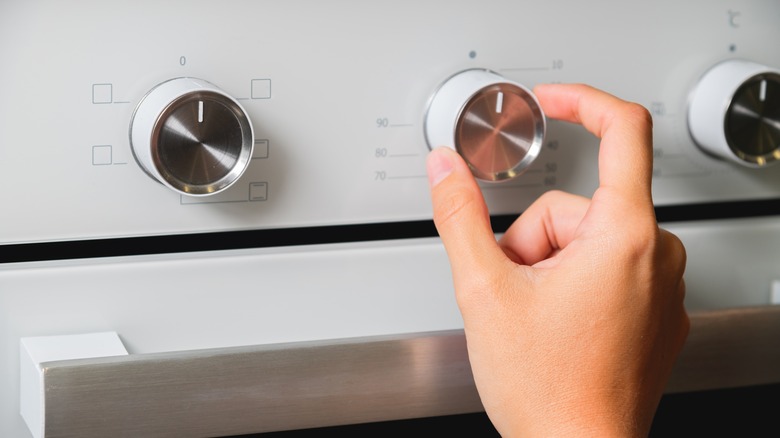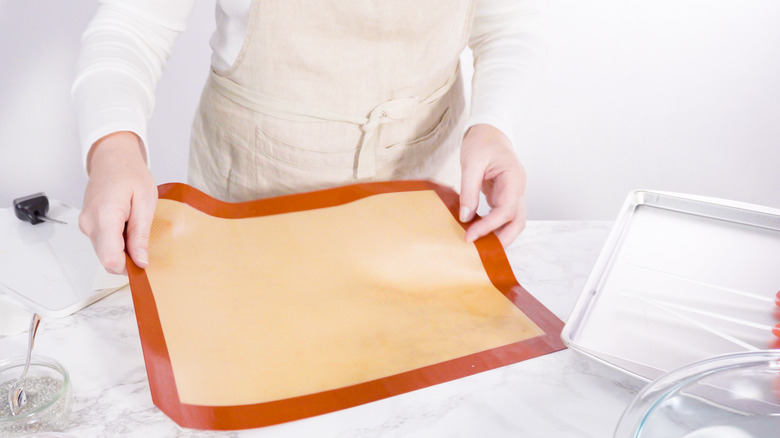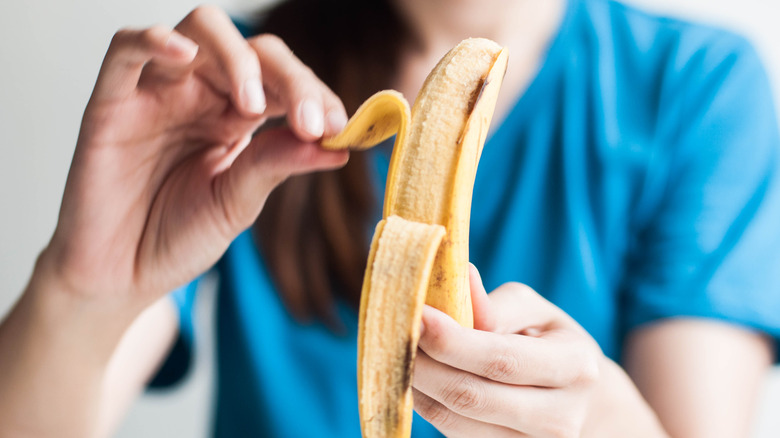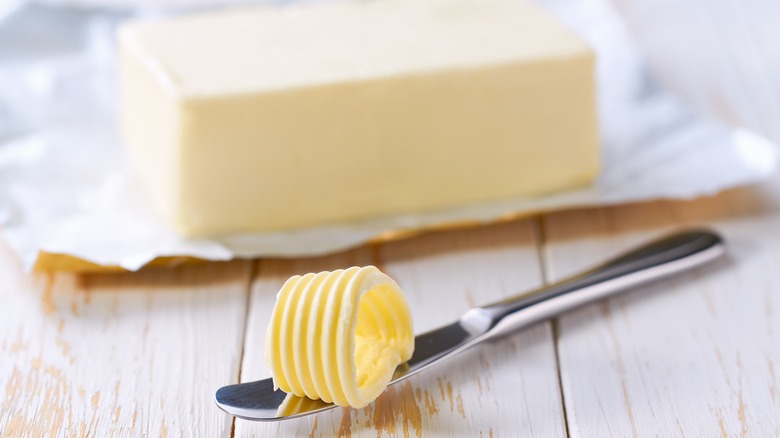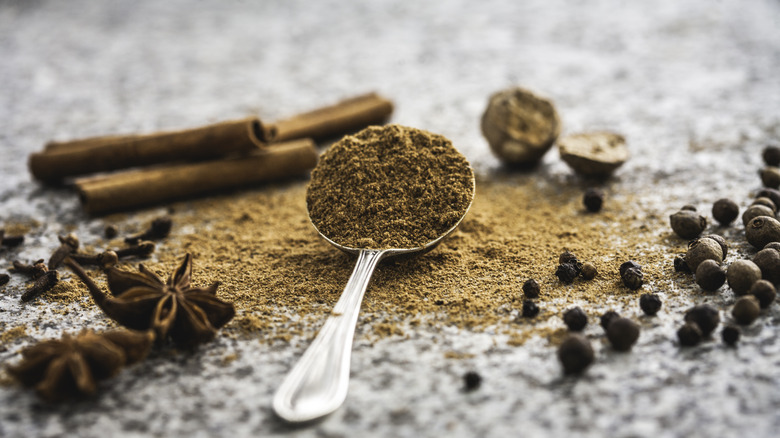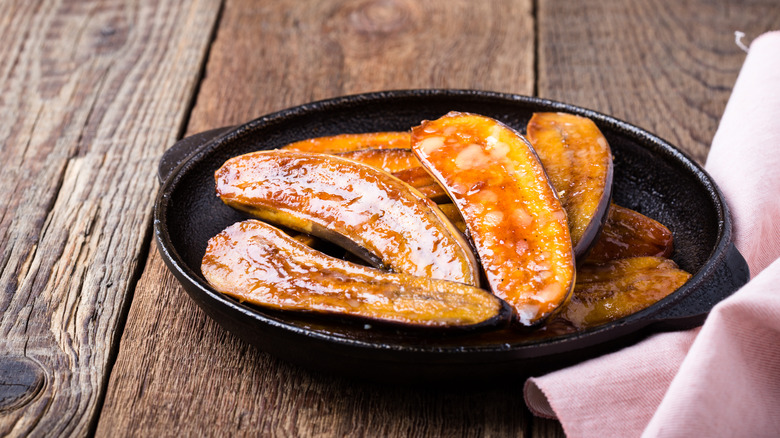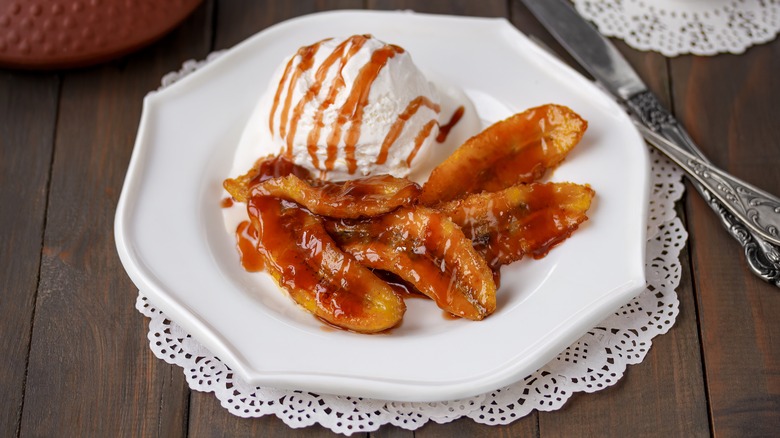8 Chef-Approved Tips For Roasting Bananas To Perfection
When it comes to the wide world of tantalizing tropical fruits, bananas often get a bad rap. Often relegated in American cooking to "healthier" recipes like smoothies, diet frozen desserts, or as a replacement for oil in baked goods like cookies, bananas rarely get the chance to shine as the star of a dish. This is a real shame, because all it takes is a little TLC to transform a simple handheld snack into the flavor-boosting ingredient you never knew you needed. Thanks to their high starch content, bananas are prime contenders for roasting. A little heat transforms those starches into caramelized goodness that packs a punch of flavor in everything from make-ahead breakfasts like baked oatmeal to sweet and spicy Caribbean-inspired dishes such as stews and curries.
To learn the secrets to the best possible roasted bananas, we turned to an expert, Curaçao-based chef and Caribbean cuisine queen Helmi Smeulders, for her tips and tricks. "There's many ways to roast bananas: with skin, peeled, in the oven, on a barbeque," says chef Smeulders. "I keep to peeled in the oven as it gives you beautifully caramelized, still quite firm bananas that can be used in different preparations for breakfast and dessert." Ready to upgrade your fruit-based recipes? Try these tips for roasting bananas to caramelized perfection.
1. Use ripe but firm bananas
First things first: Choosing the best specimen for the job. When it comes to roasting bananas, chef Smeulders has found a sweet spot. "Overripe bananas can become too mushy, while underripe ones might not develop the desired sweetness," she says. In short, save the super soft bananas for banana bread and reach for the ready-to-eat fruits for roasting.
So, what exactly are we looking for in the perfect produce for roasting? It's all about texture. The banana should be firm to the touch with just a little bit of give. Most likely, the skin will be yellow with just a few brown spots beginning to peek through, though those dark blotches are not necessarily an indication of overripeness. Just use your best judgment in terms of touch to feel for a firm fruit that feels ripe enough to snack on.
While bananas do tend to ripen faster than expected, there is the rare occasion when your bunch is just too green to use. Luckily, if you need to ripen your bananas faster, there's a hack for that. As bananas ripen, they release ethylene gas. By placing your bananas in a brown paper bag, that ethylene gas gets trapped, mixes with oxygen, and puts the whole process into overdrive — resulting in ready-to-use bananas in less time. You can speed up the process even further by adding another ethylene-releasing fruit to the bag, like an apple, pear, or avocado.
2. Turn up the heat
In order to achieve perfect caramelization on your roasted bananas, temperature matters. According to chef Smeulders, "Roasting them at 350 or 400 [degrees Fahrenheit] really makes a big difference in sweetness. Those roasted at 400 are much sweeter."
Of course, there's a reason why the bananas roasted at a higher temperature turned out so much more mouthwatering. The secret is in the caramelization process. Caramelization occurs once most of a food's moisture has evaporated and the sugar molecules start breaking down. This reaction requires high heat to work its magic — like using a blow torch on crème brûlée or cooking onions in a hot skillet. If this sounds similar to the process of browning meat, that's because it is. Both processes change a food's taste and texture, but the main difference between browning and caramelization is that the former is a product of the Maillard reaction, a tasty culinary chemical reaction involving amino acids and sugar, which alerts our brains that food is ready to be consumed.
While the final golden-brown color of roasted bananas is certainly visually appealing, it's the increased sweetness, achieved through this precise chemical reaction of caramelization, that makes them truly delicious. A light crust formed by the caramelized sugars is an added textural bonus that your tastebuds will thank you for. So, next time you plan to roast some bananas, don't be afraid to crank up the heat.
3. Prep for easy cleanup
In the excitement of trying a new recipe, don't forget to make life a little easier for yourself by prepping ahead for easy cleanup. While your oven is preheating to that all-important 400 degrees Fahrenheit, take the time to line your baking sheet with parchment paper or a reusable silicone baking mat to keep the bananas from sticking and to cut down on dishwashing time afterward.
While some home cooks prefer old-fashioned parchment paper, we're partial to the reusable option of silicone baking mats, both for their eco-friendly and money-saving qualities. The only downside to this strategy is that it does require an extra minute or two at the sink. If you find that your bananas ooze more than expected, don't worry about ruining your silicone mat — let the oven do the cleaning for you. Simply place the soiled mat on a wire rack set on a cookie sheet, return the dirty mat-lined pan to the oven, crank the heat to 450 degrees Fahrenheit, and forget about it for about an hour. Afterward, the residue should come off with a simple scrub of soap and warm water. A nonabrasive scrubber should help remove any remaining stubborn sticky spots without ruining your silicone mat.
4. Peel your bananas
While you're bound to find recipes touting the virtues of peeling versus not peeling bananas for roasting, chef Smeulders is adamant about the way she preps her fruit. "Peel the bananas and cut them in half lengthwise," she says. "This exposes more surface area for caramelization." As we've already established, caramelization is key for the perfect roasted banana. By exposing nearly the entire fruit to the oven's high heat, we can ensure even cooking and near-total caramelization for optimal sweetness.
Even a step as simple as peeling a banana has a proper technique, and it's entirely possible you've been doing it wrong your whole life. The correct way to peel a banana is to hold it stem side down, pinch the bottom with your index finger and thumb, and watch the peel split open on its own before pulling back the fibrous exterior. While the differences may seem minuscule, the main benefit of peeling a banana this way is to avoid dealing with those annoying stringy bits (aka phloem bundles) that dangle off your freshly peeled fruit.
Before you go tossing that peel, consider reducing food waste by adding it to your next cake or other baked banana treat. The nutrient-rich coating won't drastically alter the taste of your bake, but rather it will add a bit of extra moisture and even a bit of pleasant chew. Just be sure to wash those peels thoroughly, then simmer and puree them for the optimal texture.
5. Lubricate your bananas for even roasting
As with any baking or cooking method, even roasting is key to a deliciously consistent product. Thanks to its heat-conducting abilities, fat (like oil or butter) helps to keep the temperature even across the produce and to facilitate the all-important caramelization process. Chef Smeulders suggests brushing your peeled bananas with melted butter or coconut oil to achieve both an even golden-brown crust and an extra tasty final product.
Not only does an application of fat help with even heat distribution, but it also acts as a moisture barrier that prevents the bananas from drying out too quickly. While it's certainly desirable for the surface of the fruit to dry out in order to achieve caramelization, you'll want the interior to remain soft. That's where the fat comes in. Fat allows the bananas to cook without drying out, ensuring that they develop a sweet, golden-brown crust without shriveling. If you choose to go the butter route, look out for European-style brands. These butters are the best choice for browning or caramelizing because of their higher fat content (82%) compared to their American counterparts (80%). The higher fat content means that the butter will melt faster, brown quicker, and keep the banana's interior extra moist.
6. Season your bananas
No matter what you're cooking, always say yes to seasoning. The sweetness that comes from caramelization is all well and good, but by taking the time to sprinkle your bananas with a little extra goodness, you can transform the everyday fruit into something truly extraordinary. Chef Smeulders recommends using a pinch of cinnamon, nutmeg, and even a sprinkling of salt to achieve this extra boost of roasted banana flavor.
While it may seem odd to add salt to something sweet like a caramelized roasted banana, it's actually pretty standard practice in the confectionary world. When used appropriately, salt enhances just about every taste sensation there is by decreasing water activity, resulting in a higher concentration of flavors. In other words, it can make citrus taste more citrusy and make aromatic spices like cinnamon and nutmeg more fragrant. Salt also suppresses bitterness and tempers sweetness, making it the perfect pairing for roasted bananas. By adding a simple sprinkling of salt along with a pinch of cinnamon or nutmeg, you elevate the overall taste experience, bringing out the best in both the sweetness of the caramelized banana and the warm, aromatic spices. So, next time you're roasting bananas, don't forget that pinch of salt — it makes all the difference.
7. Look for the golden-brown crust
As with any piece of produce, every banana is unique. Some may contain a bit more sugar while others contain a bit more moisture — all factors that contribute to the final cook time. Instead of adhering to a standard recipe, let your senses be your guide to deciding when your bananas are roasted to perfection. Chef Smeulders says to look for an even golden-brown coating with a few bubbles on the surface. Depending on your oven, this could take anywhere from roughly 15 to 20 minutes. Five minutes may not seem like a huge range, but those precious moments could be the difference between perfectly roasted bananas and a burnt, crispy mess.
With beautifully caramelized bananas on the line, you won't want to rely solely on the kitchen timer. The best way to sense if your bananas have reached peak caramelization is to follow your nose. When you smell that distinct nutty, toffee-like aroma, similar to the scent that accompanies brown butter or caramel cooking away on the stove, you'll know it's time to check on those roasted bananas. By paying attention to the visual and olfactory cues, you'll ensure your roasted bananas achieve that perfect balance of caramelized sweetness and soft texture. So, trust your senses, and enjoy the delicious results.
8. Let the roasted bananas cool
Once your roasted bananas have achieved golden-brown perfection, it may be tempting to try them right away. Resist the urge to sneak a sample and let them cool before handing. Not only is that caramelized sugar likely to burn off your fingerprints, but the bananas will be too soft to use effectively. Chef Smeulders suggests leaving the bananas to cool for a few minutes after cooking, saying, "This helps them firm up slightly and makes them easier to handle."
That cooling time also allows the crust to harden, giving your bananas a delectably crisp crème brûlée-like coating that adds both flavor and texture to your final dish. The crucial cooling step not only enhances the texture but also ensures that the bananas are more versatile and ready for any culinary creation you might have in mind. Once they've firmed up, you can chop, slice, or mash your roasted bananas for use in your next great recipe. Try incorporating roasted bananas into pancakes, a tropical fruit salsa served over ice cream, or as a sweet addition to your morning oatmeal. You can even leave the bananas whole and serve them as the dinner party-worthy dessert, bananas Foster — and no one has to know how easy it was to make.
